The Flat Coated Retriever Rescue Network: News in April 2023
General news
The Flat Coated Retriever Rescue Network (FCRRN) thank our supporters and other readers of the newsletters(1,2,3,4,5) for their continuing interest and particularly for the comments on the February 2023 edition(6), for examples:
“Thank you for sending the newsletter – always a good read.”
“The newsletter was interesting to read, thank you. The reference to “the green light” resonated. How often in life does the knowledge of there being a safety net to catch you inspire the courage to go further, push higher or even just to keep on carrying on?”
“Thank you for your email and copy of the FCRRN February newsletter. It is good to keep up with what is happening in the world of flat coated retriever rescue.”
“Thank you for the latest FCRRN news, which is always appreciated.”
“The Robert Armstrong piece about the joys and challenges of rescue and adoption certainly reflects our experiences.”
Rehoming is quiet via rescue organisations although there is significant activity one-to-one via the Internet and the animal rescue centres are busy. Many people are struggling to make ends meet due to the cost of living pressures and the centres report a significant increase in the number of animals being surrendered by guardians who cannot afford to care for them (Wood, 2023).
Internet prices for pure bred flat coated retriever puppies have crept up to between £1600 and £1800. It is not surprising that people who have spent such an amount of money on a puppy might choose to sell that dog when she/he becomes too much for them rather than surrender the dog to a rescue organisation like the FCRRN.
Two good potential guardians have joined the FCRRN’s waiting list; a recently retired 60 year old with more than 20 years of experience of flat coated retrievers; and a vet who works part-time, lives in a national park and who has treated several flat coated retrievers. She has done extensive research and fallen for our breed; who would have thought!
Potential adopters can be reassured that experience with flat coated retrievers is not a pre-requisite for adoption through the FCRRN. The pre-requisites include a genuine willingness to identify the needs of the flat coated retriever and to respond to those needs, thereby improving the dog’s quality of life and building their trust.
Nugget
Readers of previous newsletters(5,6) will remember Nugget (pseudonym), a female flat coated retriever aged 16 months, who was potentially looking to be rehomed. The good news is that Nugget remains with her guardians where she is responding to more structured stimuli and she is a tad less excitable. Her guardians have the reassurance that the FCRRN have good potential homes for Nugget although everyone concerned would prefer her to remain with her current guardians.
Max: An ongoing rescue success and an escapologist
Readers might also recall from previous newsletters(5,6) the antics of Max (pseudonym) who was mentioned in the context of rolling in cow waste slurry and then shaking inside the car, and separately, falling into a lock and needing to be hauled out by his scruff and front legs. Max is a male flat coated retriever aged five years who had been traumatised in his early years and who is gaining confidence exponentially since his rescue in 2021.
The readers’s feedback on Max’s escapades include –
(1) Max sounds like a character but I must admit that all of my dogs have enjoyed getting extremely dirty and covering me, my car and the house….I suspect I am the cause really. (Source: FCRRN supporter with a rescued flat coated retriever).
Editor’s note: these words made me think of the line from “Anti-hero” by Taylor Swift, “It’s me, hi, I’m the problem, it’s me…;” I can identify with that line with some pride!
(2) Max made me smile. I remember Jet (rescue mixed breed) and how he loved to roll in all sorts of unmentionable matter. Also he hated being bathed and though he kept still throughout, he would make moaning noises just so we knew he was hating every minute. Then when released, before we could catch him, he would shake himself and water would be everywhere. (Source: FCRRN supporter).
Max’s guardian writes that Max has shown great proficiency at jumping especially if his guardian has (carelessly!) moved too far away and Max’s still-fragile confidence begins to falter.
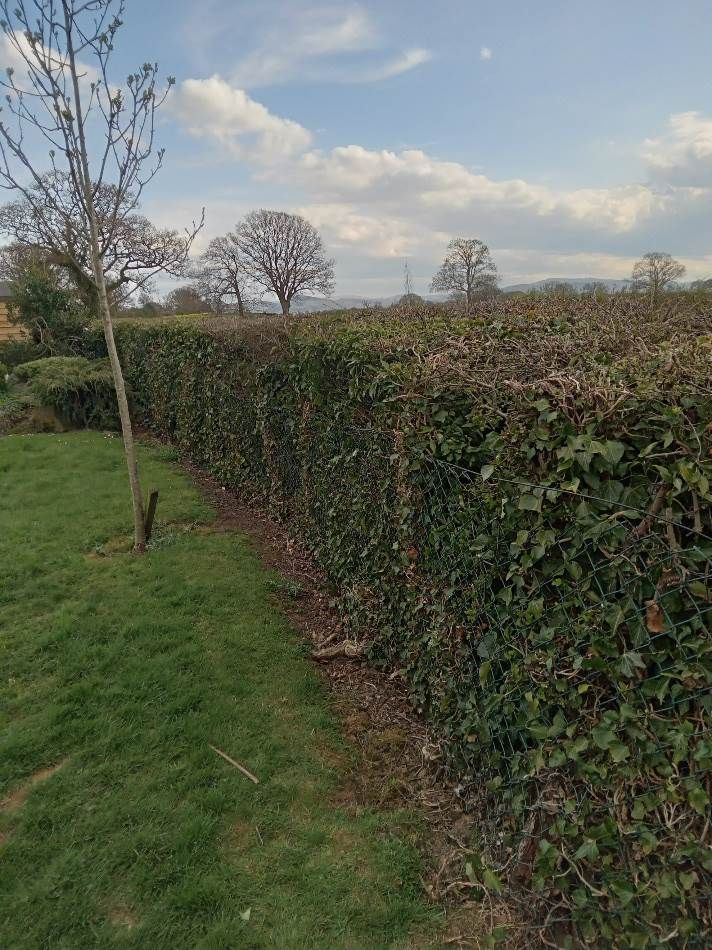
Picture: The garden hedge to the back appears fairly reasonable, if looking towards the “rockery”
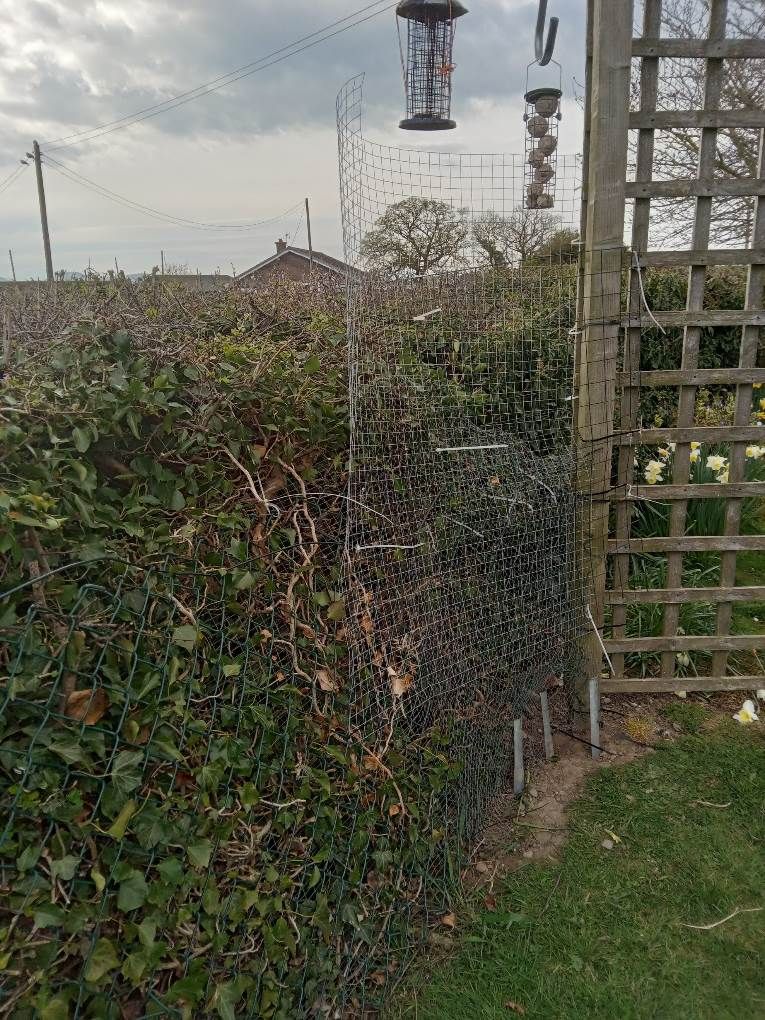
Picture: However looking towards the trellis, it is a mess due to the barricade
The barricade seeks to stop Max from exploring ways to go under, over or round as he attempts to join his guardian because she is, momentarily, in the other part of the garden. The barricade grows higher with each attempt.
This barricade is all very well…until…Max discovers his hedge climbing abilities. Note this is a thorn field hedge; it is not soft privet and it enables Max to walk along the top and around the barricade.
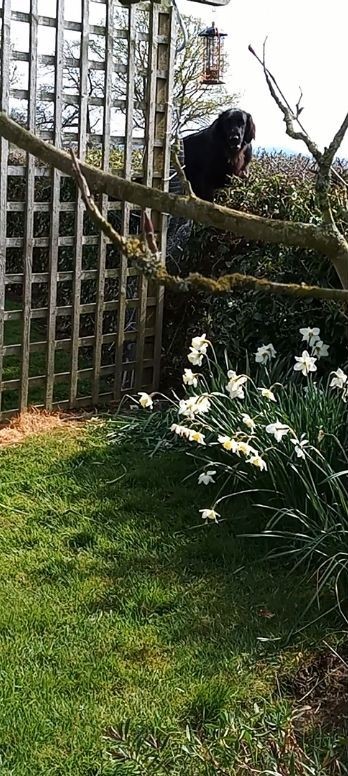
Picture: Max climbing
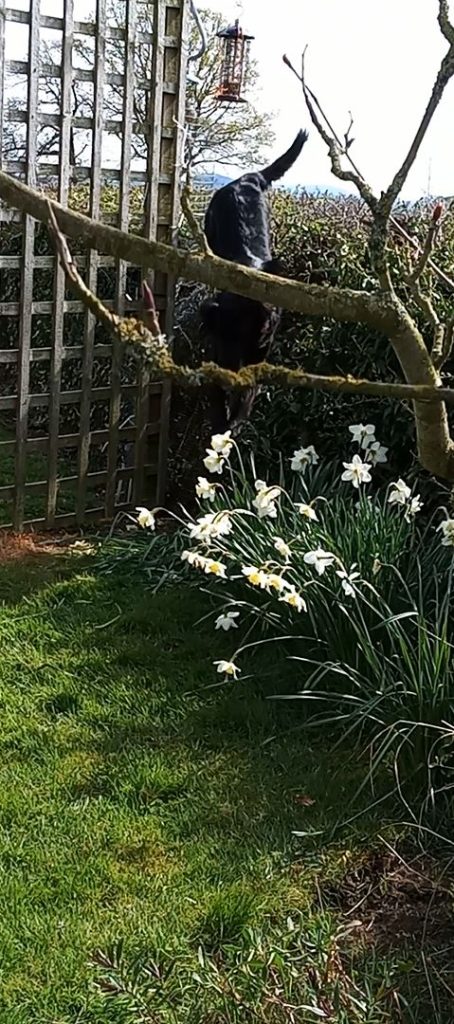
Picture: Max descending
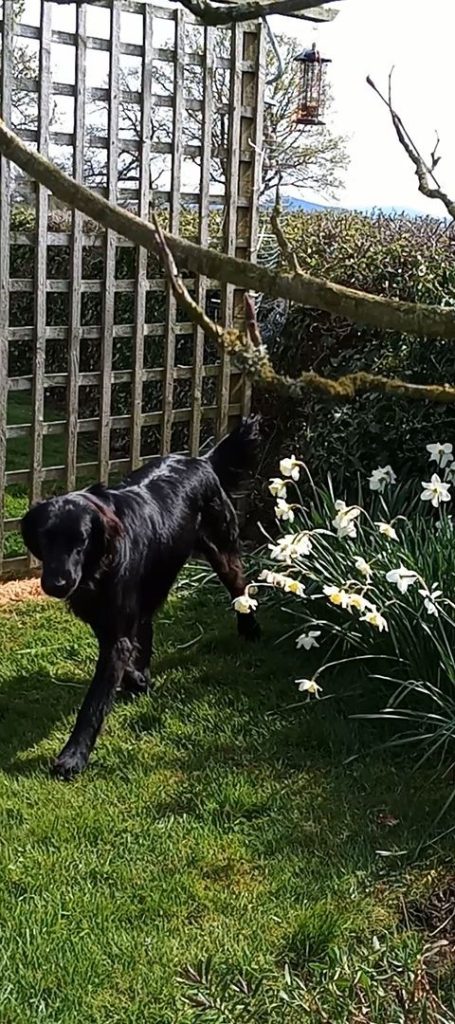
Picture: Max arriving
He is very pleased with himself and seems to be saying, “hello; what are you doing round here and why am I not involved?”
Blood doning
Rose is a six years young flat coated retriever who was rescued nearly four years ago to our home. In common with Lucie(6), Rose has recently joined the Pet Blood Bank UK and she gave her first donation last month.
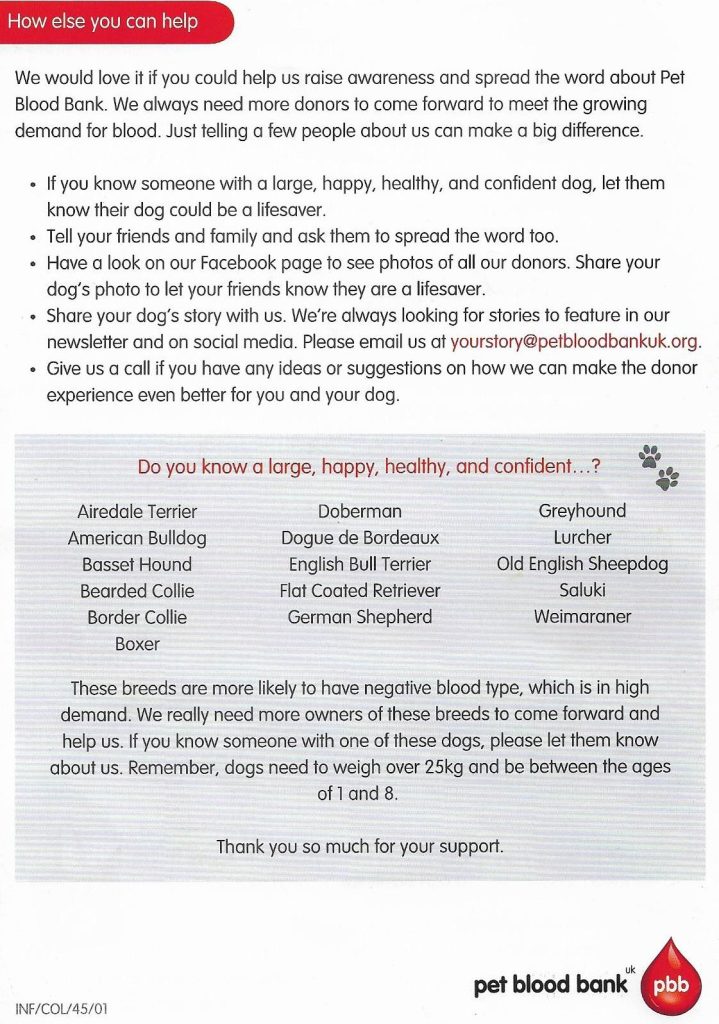
Picture: Pet Blood Bank; extract from the information sheet https://www.petbloodbankuk.org/
The FCRRN are keen to promote the Pet Blood Bank who are seeking to recruit dogs who weigh more than 25kg and who are between one and eight years. Flat coated retrievers are especially good donors because of their nature (sic) and many are Dog Erythrocyte Antigen (DEA) 1.1 negative which makes them universal donors (Cotter, 2017).
The enrolment process is very straight forward and booking an appointment near to home is easy because the Pet Blood Bank have peripatetic donation teams that travel widely across the UK.
The donation process has three parts and the guardian is encouraged to be present throughout as usually she/he is a calming influence. The three parts are –
Part 1: Pre-donation health check with a vet and a nurse.
Part 2: Donation with a different vet and two nurses which takes five to 10 minutes.
Part 3: Post-donation observation with drinks, treats, choice of a toy, bandana and photograph.
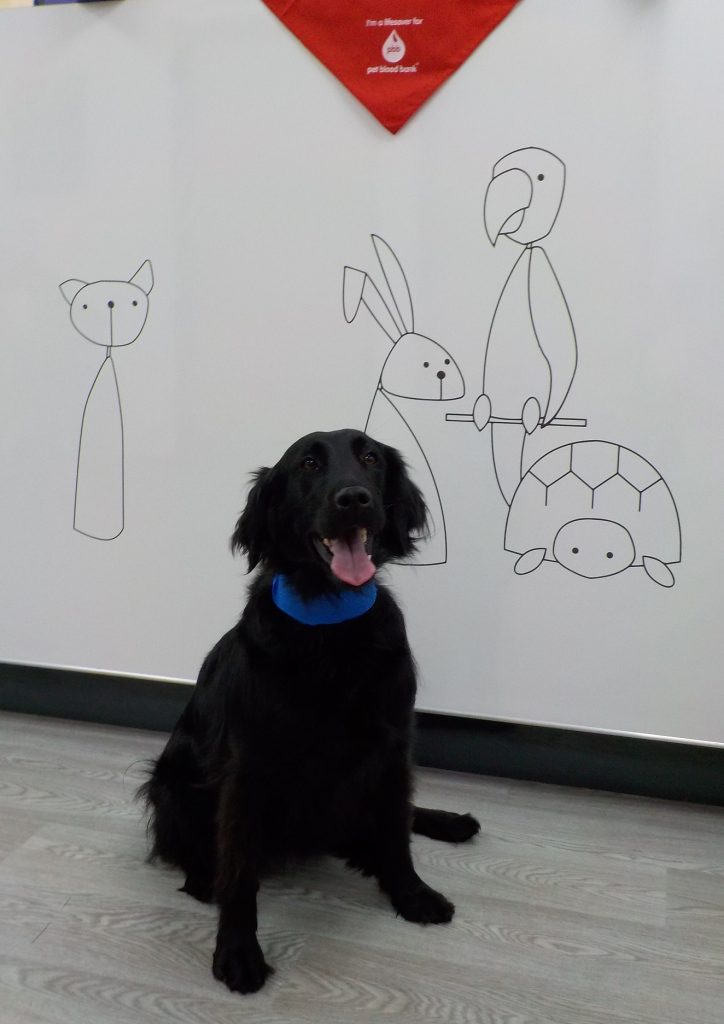
Picture: Rose during the post-donation observation period
The blue pressure dressing is removed after about 20 minutes and in total, the donation process takes about 45 minutes.
Rose was thrilled with the experience because she was only just heavy enough at 25.2kg to qualify as a donor and so the donation team made extra fuss of “Little Rose.” Her blood type is DEA 1.1 negative hence she can donate every two months and she has an appointment in May 2023. This appointment will be a joint visit with Lucie all being well.
It was heartening to see how Rose enjoyed the donation process particularly in view of her condition when she was rescued weighing only 19kg and with a chronic knee injury that had not been treated.
I should reiterate that the Pet Blood Bank are a registered charity (Scottish Charity No: 037745) and they use fundraising to subsidise their costs. The costs charged to vets for blood or platelets cover the funds needed to run the service and the Pet Blood Bank have an agreement with vets who use the donated products that there is no mark-up charge to guardians. See: https://www.petbloodbankuk.org/about-us/our-commitment-to-welfare/
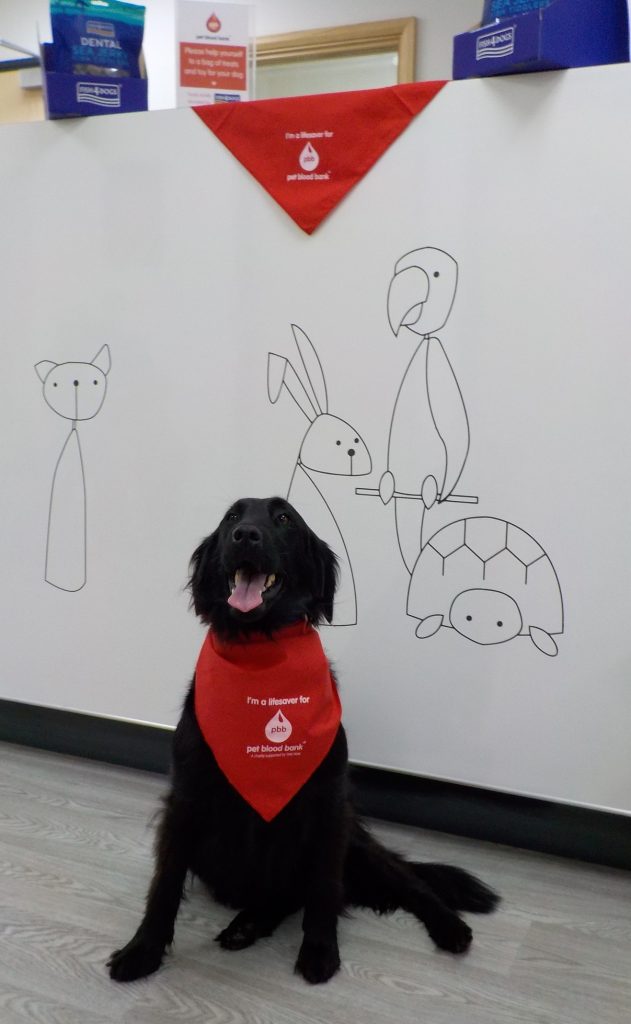
Picture: Rose homeward bound
Editor’s note: feedback on Lucie’s blood doning(6) –
(1) I found the blood donation section interesting. Certainly our two rescue flat coated retrievers have good temperaments, but to lie still for the blood donation, as the website informs is required, would be beyond their current skill set! (Source: FCRRN supporters).
(2) We had never considered the obvious need for animals to provide blood donations. How lovely that Lucie’s calm temperament enabled her to be generous. Well done to her!
(Source: FCRRN supporters).
Please consider your flat coated retriever as a blood donor; there is further information at:
https://www.petbloodbankuk.org/
https://uk.news.yahoo.com/dog-owners-urged-sign-pets-144515664.html
Flat coated retrievers and cancers
There have been continuing discussions about this subject following the article in the September 2022 newsletter(4) and the news of the death of Robin (pseudonym), a rescue flat coated retriever aged five years.
Several publications from the Kennel Club cross-sectional survey in 2014 have been quoted including the most recent paper by Lewis and co-authors (Lewis et alia, 2018).
I am familiar with the survey which is cited, along with several of the papers emanating from the survey, in my discussion paper on options to improve the welfare of flat coated retrievers (Robbé, 2017; 2018).
The current conclusion I have reached is that there is still no valid evidence to confirm the hypothesis that some cancers are commoner in flat coated retrievers than in other pedigree breeds e.g. Dobermann, Rottweiler and Weimaraner, inter alia.
Many guardians have experienced the grief from the death of a young flat coated retriever from cancer. Full disclosure: I continue to grieve for flat coated retrievers aged seven, eight, and 10 who died of cancer. Nevertheless personal anecdotes provide evidence of weak power and, in common with case series (Dobson, 2013; Egenvall et alia, 2000), they represent highly selective reporting with significant biases and there is no evidence for their representativeness of our breed.
Cross-sectional surveys, like the Kennel Club survey, are able to gather data quickly and the investigators have control over how the data are presented. Cross-sectional surveys have disadvantages that include recall bias, response bias, and the fact that associations might not be cause and effect (Bowling, 2014).
Disadvantages in the Kennel Club survey –
Recall biases: guardians were asked to provide information on a death from as long ago as 10 years before the survey; type of disease classification e.g. clinical assessment, histology, post-mortem examination. Less than 6% of deaths had a post-mortem which indicates that between six and 13 flat coated retrievers only had the highest accuracy for their diagnosis.
Response biases: the survey was web-based so only computer users could respond; only one in a hundred guardians responded; only dogs registered with the Kennel Club were included; 225 deaths out of a population of about 12,000 flat coated retrievers were analysed and there was no information about the representativeness of the 225 deaths in relation to the other flat coated retrievers who died during the 10 year period.
Associations: no information on potential confounders of possible associations between cancers and breeds e.g. age, gender, parity, inter alia. The small number of cases indicate that the apparent differences within our breed and between breeds regarding mortality from cancers compared to other causes are likely to be due to the biases in the survey.
In my opinion, the Kennel Club survey and the various case series only demonstrate the need for further research. This research should involve large, validated, population based cohort studies to investigate of the causes of death both within and between dog breeds.
Flat coated retriever death: Brodie
Several supporters of the FCRRN have shared the sad news of the death of Brodie, a black, male flat coated retriever aged eight years. According to press reports(a,b,c,d) Brodie had been reported as missing by his guardians in January 2023 in the Manchester area and in early April his body was found more than 30 miles away in the Sheffield area. One can empathise with the distress to his guardians caused by the news of his death compounded by the evidence that Brodie was malnourished and maltreated.
The RSPCA and South Yorkshire Police are investigating. If someone has information then they are urged to contact the RSPCA on 0300 1234 999 or South Yorkshire Police on 101 quoting incident number 858 of April 3rd 2023.
(a) Manchester Evening News
https://www.pressreader.com/uk/manchester-evening-news/20230408/281784223370028
(b) Quest Media Network
(c) The Star (Sheffield)
(d) Yorkshire Live
https://www.examinerlive.co.uk/news/local-news/tragic-end-beloved-missing-dog-26643665.amp
Happier news: Yumove
There was a heartening news item in the Observer on March 5th 2023 in the consumer column of Anna Tims (Tims, 2023). A reader reported that her dog had recently been put to sleep and the reader contacted the online provider, Yumove, https://yumove.co.uk/ to cancel her dog’s monthly subscription for his joint supplement. Yumove promptly sent an email with their condolences and a refund for the last month’s supply of pills. Then a few days later, the guardian received a handwritten card of condolence and some forget-me-not seeds to plant in commemoration of her dog.
Conclusions
It is good to end this newsletter on a positive item and to recall the other happy news of Nugget, Max, blood doning, recruitment of adopters, and the feedback from readers.
Please could you remember the Flat Coated Retriever Rescue Network if, via any route, you learn that a surrender or adoption is being considered?
Dr. Iain J. Robbé
On behalf of the Flat Coated Retriever Rescue Network (FCRRN)
Email: walesandwm@gmail.com
FCRRN_07
“Rescues R Us”
Experts: none of the FCRRN is acting in the capacity of an expert; each contributor is offering their advice based on accessible evidence. If you are concerned about any subject in the newsletters then you should consult a veterinary professional, legal professional or other professional.
© 2023 Flat Coated Retriever Rescue Network
(1) http://www.iainrobbe.com/fcrrn_01/
(2) http://www.iainrobbe.com/fcrrn_02/
(3) http://www.iainrobbe.com/fcrrn_03/
(4) http://www.iainrobbe.com/fcrrn_04/
(5) http://www.iainrobbe.com/fcrrn_05/
(6) http://www.iainrobbe.com/fcrrn_06/
Bowling, A. (2014). Research Methods in Health. Buckingham: Open University Press.
Cotter, S. M. (2017). Blood Groups and Blood Transfusions in Dogs. Retrieved from:
www.msdvetmanual.com/dog-owners/blood-disorders-of-dogs/blood-groups-and-blood-transfusions-in-dogs#
www.msdvetmanual.com/circulatory-system/blood-groups-and-blood-transfusions/overview-of-blood-groups-and-blood-transfusions-in-animals
Dobson, J. M. (2013) Breed-Predispositions to Cancer in Pedigree Dogs. ISRN Veterinary Science. doi:10.1155/2013/941275
Egenvall, A., et alia (2000). Age Pattern of Mortality in Eight Breeds. Preventive Veterinary Medicine, 46, 1-14.
Lewis, T. W., et alia. (2018) Longevity and Mortality in Kennel Club Registered Dog Breeds in the UK in 2014. Canine Genetics and Epidemiology, 5(10). doi:10.1186/s40575-018-0066-8
Robbé, I. J. (2017; revised in 2018). Options to Improve the Welfare of Flat Coated Retrievers against Inherited Diseases.pdf
Tims, A. (2023, March 5). Aftercare For My Beloved Dog. Observer, p. 50.
Wood, Z. (2023, March 26). Fear of Cats Going Hungry. Guardian, p. 35.
